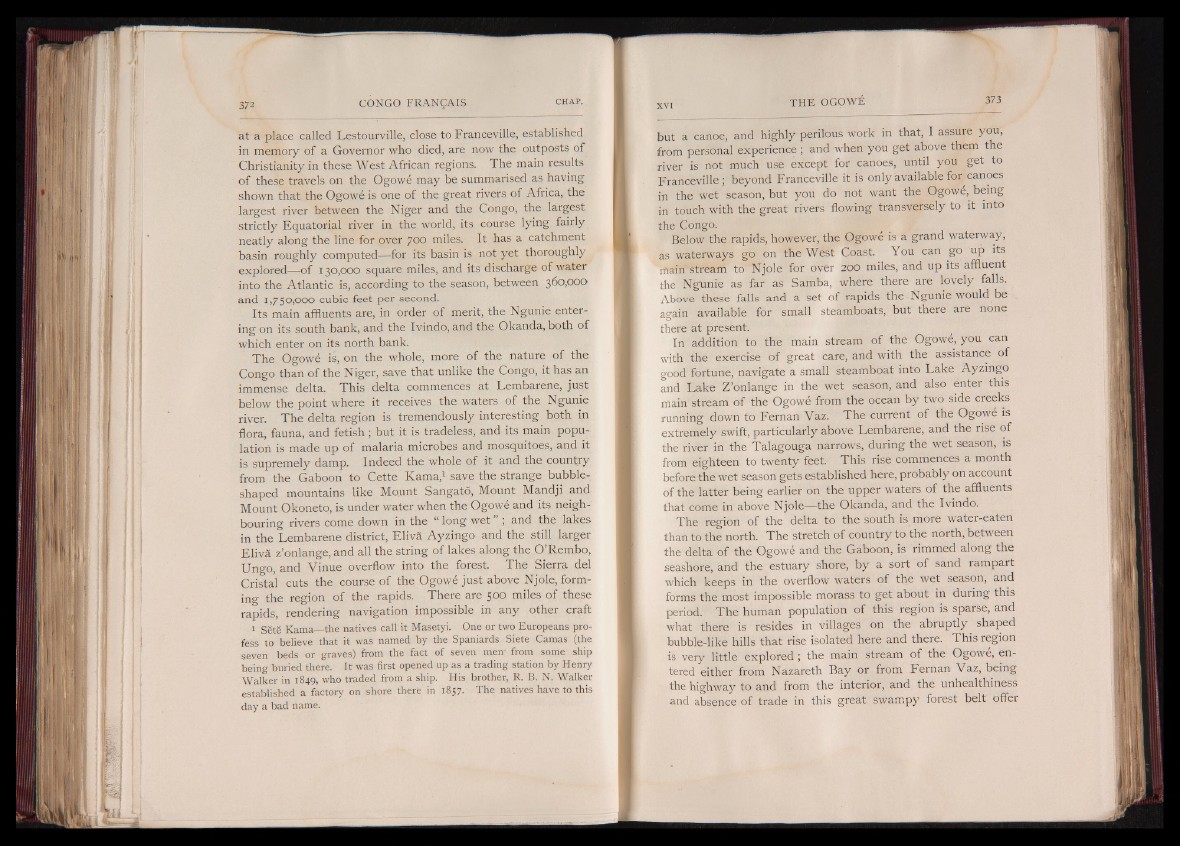
at a place called Lestourville, close to Franceville, established
in memory of a Governor who died, are now the outposts of
Christianity in these West African regions. The main results
of these travels on the Ogowe may be summarised as having
shown that the Ogowd is one of the great rivers of Africa, the
largest river between the Niger and the Congo, the largest
strictly Equatorial river in the world, its course lying fairly
neatly along the line for over 700 miles. It has a catchment
basin roughly computed— for its basin is not yet thoroughly
explored— of 130,000 square miles, and its discharge of water
into the Atlantic is, according to the season, between 360,000
and 1,750,000 cubic feet per second.
Its main affluents are, in order of merit, the Ngunie entering
on its south bank, and the Ivindo, and the Okanda, both of
which enter on its north bank.
The Ogowe is, on the whole, more of the nature of the
Congo than of the Niger, save that unlike the Congo, it has an
immense delta. This delta commences at Lembarene, just
below the point where it receives the waters of the Ngunie
river. The delta region is tremendously interesting both in
flora, fauna, and fetish; but it is tradeless, and its main population
is made up of malaria microbes and mosquitoes, and it
is supremely damp. Indeed the whole of it and the country
from the Gaboon to Cette Kama,1 save the strange bubbleshaped
mountains like Mo.unt Sangato, Mount Mandji and
Mount Okoneto, is under water when the Ogowe and its neighbouring
rivers come down in the “ long wet ; and the lakes
in the Lembarene district, Eliva Ayzingo and the still larger
Eliva z’onlange, and all the string of lakes along the O’Rembo,
Ungo, and Vinue overflow into the forest. The Sierra del
Cristal cuts the course of the Ogowe just above Njole, forming
the region of the rapids. There are 500 miles of these
rapids, rendering navigation impossible in any other craft
1 Sete Kama— the natives call it Masetyi. One or two Europeans profess
to believe that it was named by the Spaniards Siete Camas (the
seven beds or graves) from the fact of seven men' from some ship
being buried there. It was first opened up as a trading station by Henry
Walker in 1849, who traded from a ship. His brother, R. B. N. Walker
established a factory on shore there in 1857. The natives have to this
day a bad name.
but a canoe, and highly perilous work in that, I assure you,
from personal experience ; and when you get above them the
river is not much use except for canoes, until you get to
Franceville; beyond Franceville it is only available for canoes
in the wet season, but you do not want the Ogowe, being
in touch with the great rivers flowing transversely to it into
the Congo.
Below the rapids, however, the Ogowe is a grand waterway,
as waterways go on the West Coast. You can go up its
main stream to Njole for over 200 miles, and up its affluent
the Ngunie as far as Samba, where there are lovely falls.
Above these falls and a set of rapids the -Ngunie would be
again available for small steamboats, but there are none
there at present.
In addition to the main stream of the Ogowe, you can
with the exercise of great care, and with the assistance of
good fortune, navigate a small steamboat into Lake Ayzingo
and Lake Z’onlange in the wet season, and also enter this
main stream of the Ogowe from the ocean by two side creeks
running down to Fernan Vaz. The current of the Ogowe is
extremely swift, particularly above Lembarene, and the rise of
the river in the Talagouga narrows, during the wet season, is
from eighteen to twenty feet. This rise commences a month
before the wet season gets established here, probably on account
of the latter being earlier on the upper waters of the affluents
that come in above Njole— the Okanda, and the Ivindo.
The region of the delta to the south is more water-eaten
than to the north. The stretch of country to the north, between
the delta of the Ogowe and the Gaboon, is rimmed along the
seashore, and the estuary shore, by a sort of sand rampart
which keeps in the overflow waters of the wet season, and
forms the most impossible morass to get about in during this
period. The human population of this region is sparse, and
what there is resides in villages on the abruptly shaped
bubble-like hills that rise isolated here and there. This region
is very little explored; the main stream of the Ogowd, entered
either from Nazareth Bay or from Fernan Vaz, being
the highway to and from the interior, and the unhealthiness
and absence of trade in this great swampy forest belt offer